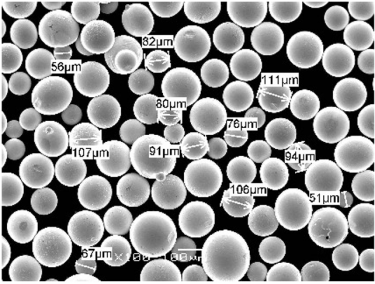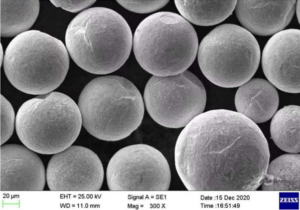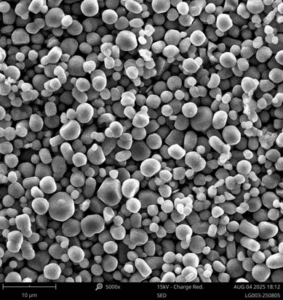Pós de cobalto-cromo(CoCr), geralmente chamados de pós de CoCr, são materiais essenciais em diversos processos de fabricação avançados, principalmente em setores como o aeroespacial, de implantes médicos e automotivo. Mas o que torna esses pós tão especiais? Por que eles são tão comumente usados em aplicações de alto desempenho? Vamos mergulhar fundo no fascinante mundo dos pós de cobalto-cromo, explorando suas propriedades, aplicações e tudo mais.
Visão geral dos pós de cobalto-cromo
Os pós de cobalto-cromo são ligas compostas principalmente de cobalto (Co) e cromo (Cr), geralmente com pequenas adições de outros elementos, como molibdênio, tungstênio ou carbono. Esses pós são reverenciados por sua excepcional resistência ao desgaste, resistência à corrosão e resistência a altas temperaturas. Essas propriedades os tornam ideais para ambientes em que os materiais são submetidos a condições extremas, como na boca (implantes dentários), no motor (lâminas de turbina) ou até mesmo no corpo humano (substituições de quadril).

Composição dos pós de cobalto-cromo
A composição dos pós de cobalto-cromo pode variar de acordo com os requisitos específicos da aplicação. A composição típica inclui:
| Elemento | Conteúdo (%) |
|---|---|
| Cobalto (Co) | 50-70% |
| Cromo (Cr) | 20-30% |
| Molibdênio (Mo) | 5-10% |
| Tungstênio (W) | 0-5% |
| Carbono (C) | 0.5-2% |
| Outros (Ni, Fe, etc.) | 0-5% |
Propriedades e características dos pós de cobalto-cromo
Os pós de cobalto-cromo apresentam uma combinação única de propriedades que os tornam indispensáveis em aplicações de alto desempenho. Algumas das principais características incluem:
- Alta resistência em temperaturas elevadas: Esses pós mantêm sua resistência mecânica mesmo em altas temperaturas, o que os torna ideais para uso em turbinas e motores.
- Excelente resistência ao desgaste e à corrosão: A presença do cromo proporciona excepcional resistência à corrosão, enquanto a dureza da matriz de cobalto garante resistência ao desgaste, perfeita para implantes dentários e ortopédicos.
- Biocompatibilidade: As ligas de CoCr são biocompatíveis, o que significa que não são rejeitadas pelo corpo humano. Isso é particularmente importante para implantes médicos.
- Resistência à fadiga: As ligas de cobalto-cromo podem suportar tensões repetidas sem fraturar, o que as torna adequadas para peças sujeitas a cargas cíclicas.
Principais modelos de Pós de cobalto-cromo
Há vários graus e modelos específicos de pós de cobalto-cromo disponíveis no mercado, cada um deles adaptado a diferentes aplicações. Veja a seguir uma análise mais detalhada dos dez modelos mais importantes:
- CoCrMo (ASTM F75)
- Descrição: Essa é a liga de cobalto-cromo-molibdênio mais comumente usada para implantes médicos, especialmente para aplicações ortopédicas e odontológicas.
- Propriedades: Alta biocompatibilidade, resistência à corrosão e excelente resistência ao desgaste.
- CoCrW (Stellite 21)
- Descrição: Conhecida por sua excepcional resistência ao desgaste, essa liga é usada em assentos de válvulas, rolamentos e ferramentas de corte.
- Propriedades: Alta dureza, excelente resistência a altas temperaturas e boa resistência à corrosão.
- CoCrNiMo (ASTM F562)
- Descrição: Usado principalmente em instrumentos cirúrgicos e componentes de alta resistência.
- Propriedades: Alta resistência, boa ductilidade e resistência à corrosão.
- CoCrMoC (ASTM F90)
- Descrição: Uma variante com adições de carbono para melhorar a dureza.
- Propriedades: Maior resistência ao desgaste, adequado para aplicações de alta tensão.
- CoCrAlY (AMS 5894)
- Descrição: Usado em aplicações aeroespaciais, especialmente em lâminas de turbina.
- Propriedades: Alta resistência à oxidação em temperaturas elevadas, boas propriedades mecânicas.
- CoCrFeMnNi (liga de alta entropia)
- Descrição: Uma liga mais recente usada em aplicações de pesquisa avançada por suas propriedades exclusivas.
- Propriedades: Boa ductilidade, força e resistência à corrosão.
- CoCrMoTi
- Descrição: A adição de titânio melhora a biocompatibilidade e reduz a densidade.
- Propriedades: Leve, com alta resistência à corrosão, adequado para implantes médicos.
- CoCrSiW
- Descrição: Essa liga é usada em revestimentos resistentes ao desgaste para aplicações industriais.
- Propriedades: Alta dureza, excelente resistência ao desgaste e boa estabilidade em altas temperaturas.
- CoCrMoNb
- Descrição: A adição de nióbio aumenta a força e a resistência à fadiga.
- Propriedades: Propriedades mecânicas aprimoradas, adequadas para componentes aeroespaciais.
- CoCrZr
- Descrição: A adição de zircônio melhora a biocompatibilidade e a resistência à corrosão.
- Propriedades: Alta resistência à corrosão, adequada para implantes odontológicos e ortopédicos.






Aplicações de pós de cobalto-cromo
Os pós de cobalto-cromo são materiais versáteis usados em vários setores. Veja a seguir algumas de suas aplicações mais comuns:
| Aplicativo | Setor | Detalhes |
|---|---|---|
| Implantes dentários | Médico | As ligas de CoCr são usadas em coroas, pontes e estruturas dentárias. |
| Implantes de quadril e joelho | Médico | Devido à sua biocompatibilidade e resistência ao desgaste, as ligas de CoCr são usadas em substituições de articulações. |
| Lâminas da turbina | Aeroespacial | Os pós de CoCr são usados em motores a jato devido à sua resistência a altas temperaturas. |
| Assentos e rolamentos de válvulas | Automotivo | A alta resistência ao desgaste os torna ideais para esses componentes. |
| Ferramentas de corte | Industrial | As ligas de CoCr são usadas em ferramentas por sua dureza e durabilidade. |
| Componentes aeroespaciais | Aeroespacial | Usado em componentes críticos de alta tensão devido à sua resistência à fadiga. |
| Próteses | Médico | As ligas de CoCr são usadas na produção de próteses duráveis e biocompatíveis. |
| Revestimentos resistentes ao desgaste | Industrial | Usado em revestimentos para prolongar a vida útil de equipamentos expostos a condições adversas. |
Especificações, tamanhos, classes e padrões
Os pós de cobalto-cromo são fornecidos em várias especificações, tamanhos e graus, cada um adaptado a aplicações específicas. A tabela abaixo resume as principais especificações:
| Especificação | Grau | Tamanho da partícula (µm) | Padrão |
|---|---|---|---|
| ASTM F75 | Médico | 15-45 | ASTM F75 |
| AMS 5894 | Aeroespacial | 10-53 | AMS 5894 |
| ASTM F90 | Médico | 20-50 | ASTM F90 |
| Stellite 21 | Industrial | 15-63 | ASME BPVC |
| ASTM F562 | Médico | 25-45 | ASTM F562 |
| CoCrAlY | Aeroespacial | 10-50 | AMS 5894 |
| CoCrFeMnNi | Pesquisa | 10-45 | Personalizado |
| CoCrMoTi | Médico | 20-45 | ISO 5832-4 |
| CoCrSiW | Industrial | 15-63 | ASME BPVC |
| CoCrMoNb | Aeroespacial | 10-50 | AMS 5894 |
Fornecedores e preços
O custo dos pós de cobalto-cromo varia de acordo com o grau, o tamanho da partícula e o fornecedor. Veja a seguir um detalhamento de alguns fornecedores e seus preços:
| Fornecedor | Grau | Preço (USD/kg) | País |
|---|---|---|---|
| Tecnologia Carpenter | ASTM F75 | $250 – $300 | EUA |
| Sandvik | Stellite 21 | $200 – $250 | Suécia |
| Arcam AB (GE Additive) | CoCrMoTi | $300 – $350 | Suécia |
| HC Starck | CoCrAlY | $400 – $450 | Alemanha |
| Metais ATI | ASTM F90 | $280 – $320 | EUA |
| Tecnologia LPW | CoCrFeMnNi | $350 – $400 | REINO UNIDO |
| EOS GmbH | ASTM F562 | $270 – $320 | Alemanha |
| Tecnologias de superfície da Praxair | CoCrSiW | $200 – $260 | EUA |
| Hoganas | CoCrMoNb | $320 – $380 | Suécia |
| Kennametal | CoCrZr | $250 – $310 | EUA |
Vantagens e limitações do Pós de cobalto-cromo
Como qualquer material, os pós de cobalto-cromo têm seus pontos fortes e fracos. Vamos explorá-los:
| Vantagens | Limitações |
|---|---|
| Alta resistência à corrosão | Custo: O cobalto e o cromo são materiais caros. |
| Excelente resistência ao desgaste | Densidade: Mais pesado do que algumas alternativas, como as ligas de titânio. |
| Resistência a altas temperaturas | Usinabilidade: As ligas de CoCr podem ser difíceis de usinar. |
| Biocompatibilidade | Disponibilidade: Oferta limitada em comparação com ligas mais comuns. |
| Resistência à fadiga | Complexidade de processamento: Requer controle preciso durante a fabricação. |
| Versatilidade em todos os setores | Impacto ambiental: A mineração e o refino do cobalto podem ter consequências ambientais significativas. |

perguntas frequentes
Q1: Para que os pós de cobalto-cromo são usados principalmente?
A1: Os pós de cobalto-cromo são usados principalmente em aplicações de alto desempenho que exigem materiais com alta resistência, resistência ao desgaste e resistência à corrosão. Eles são amplamente utilizados nos setores médico, aeroespacial e industrial.
P2: As ligas de cobalto-cromo são seguras para implantes médicos?
A2: Sim, as ligas de cobalto-cromo são biocompatíveis, o que as torna seguras para uso em implantes médicos, como coroas dentárias, próteses de quadril e joelho.
P3: Como os pós de cobalto-cromo se comparam às ligas de titânio?
A3: Os pós de cobalto-cromo oferecem melhor resistência ao desgaste e maior resistência a temperaturas elevadas em comparação com as ligas de titânio. Entretanto, o titânio é mais leve e, geralmente, mais fácil de usinar.
Q4: Qual é o custo típico dos pós de cobalto-cromo?
A4: O custo varia de acordo com o grau e o fornecedor, mas geralmente varia de $200 a $450 por quilograma.
Q5: Quais são os desafios no processamento de pós de cobalto-cromo?
A5: Os desafios de processamento incluem o alto custo das matérias-primas, a complexidade da usinagem e a necessidade de controle preciso durante a fabricação para evitar defeitos.
Q6: Quais são os setores que mais se beneficiam dos pós de cobalto-cromo?
A6: Os setores médico e aeroespacial se beneficiam significativamente do uso de pós de cobalto-cromo devido aos seus exigentes requisitos de desempenho do material.
Q7: Existem preocupações ambientais associadas aos pós de cobalto-cromo?
A7: Sim, a extração e o processamento de cobalto e cromo podem causar impactos ambientais, principalmente nas regiões de mineração onde esses metais são obtidos.
Q8: Os pós de cobalto-cromo podem ser usados na impressão 3D?
A8: Com certeza! Os pós de CoCr são comumente usados na manufatura aditiva para produzir componentes complexos e de alto desempenho.
Q9: Como os pós de cobalto-cromo melhoram o desempenho das ferramentas de corte?
A9: A alta resistência ao desgaste e a dureza das ligas de CoCr as tornam ideais para ferramentas de corte, permitindo uma vida útil mais longa e cortes mais precisos.
Q10: Qual é o futuro dos pós de cobalto-cromo na fabricação?
A10: Com os avanços contínuos na ciência dos materiais, espera-se que os pós de cobalto-cromo continuem a ser cruciais em aplicações de ponta, especialmente na fabricação de aditivos e na engenharia biomédica.
Conclusão
Os pós de cobalto-cromo são mais do que apenas uma mistura de metais; eles são a pedra angular da engenharia moderna e dos avanços médicos. Seja no motor de um avião a jato ou dentro do corpo de um paciente, as propriedades exclusivas desses pós garantem que eles atendam às rigorosas demandas de aplicações de alto desempenho.

